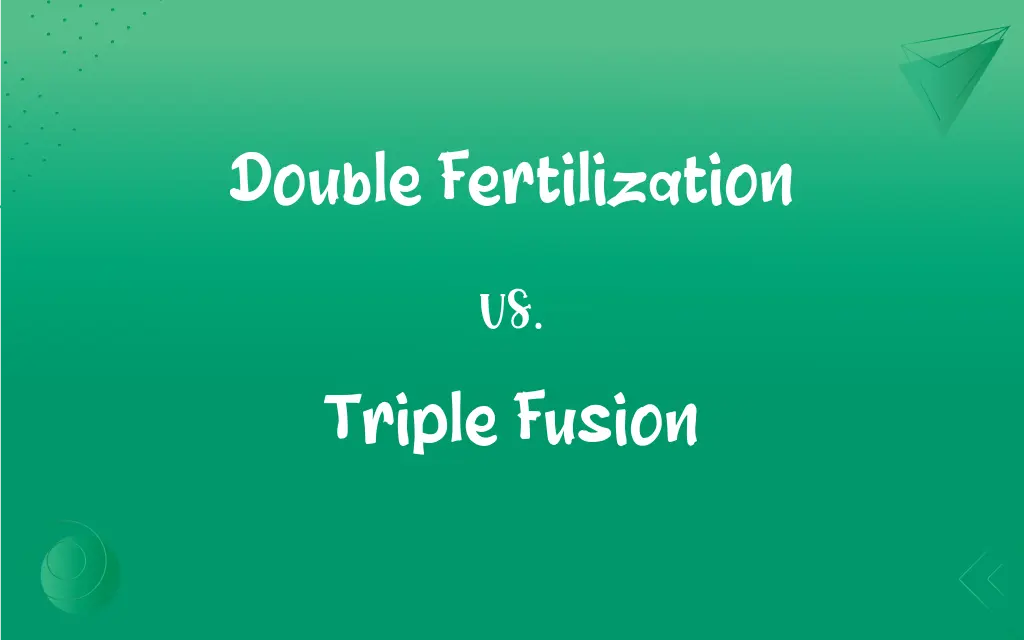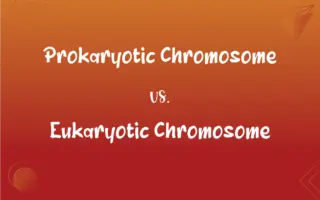Double Fertilization vs. Triple Fusion: What's the Difference?
Edited by Janet White || By Harlon Moss || Updated on October 27, 2023
Double fertilization involves two sperm cells fertilizing two different cells in plants, while triple fusion is one of these events where a sperm cell fuses with two nuclei in the central cell.

Key Differences
Double fertilization and triple fusion are specialized reproductive processes observed in angiosperms, or flowering plants. These terms represent distinct yet interconnected steps in the plant's reproductive cycle.
Double fertilization is unique to angiosperms and involves the fusion of two male gametes (sperm cells) with two female cells in the ovule. This process ensures that seeds contain both an embryo and nourishing tissue, called endosperm.
Triple fusion, on the other hand, is a part of the double fertilization process. It refers specifically to the event where one sperm cell fuses with the two nuclei present in the central cell of the ovule, resulting in a triploid nucleus, which develops into the endosperm.
While both double fertilization and triple fusion are critical for seed formation in flowering plants, they aren't synonymous. Double fertilization encompasses the entire two-step fertilization process, while triple fusion focuses on the formation of the endosperm.
Understanding both double fertilization and triple fusion is essential for plant breeders and botanists, as they play a crucial role in seed development and the propagation of angiosperm species.
ADVERTISEMENT
Comparison Chart
Definition
Two-step fertilization process in angiosperms
Fusion of one sperm with two nuclei
Result
Produces embryo and endosperm in seed
Produces triploid nucleus for endosperm
Cells Involved
Two sperm cells, egg cell, and central cell
One sperm cell and central cell with two nuclei
Significance
Ensures seeds have both embryo and nourishing tissue
Produces nourishing tissue for the growing embryo
Example of Occurrence
Occurs in all angiosperms
Is a part of double fertilization in angiosperms
ADVERTISEMENT
Double Fertilization and Triple Fusion Definitions
Double Fertilization
A two-step fertilization process unique to angiosperms.
Double fertilization in flowering plants ensures the formation of both embryo and endosperm in seeds.
Triple Fusion
The event leading to the creation of nourishing tissue in seeds.
Without triple fusion, seeds wouldn't have the essential endosperm for nourishment.
Double Fertilization
A reproductive process producing seeds with an embryo and endosperm.
Through double fertilization, angiosperms have a competitive advantage in seed viability.
Triple Fusion
Fusion of a sperm cell with two nuclei in a central cell.
Triple fusion leads to the formation of the triploid nucleus, critical for endosperm development.
Double Fertilization
Fusion of two male gametes with two female cells in an ovule.
The uniqueness of angiosperms partly lies in their double fertilization mechanism.
Triple Fusion
Fusion event forming the base for endosperm development.
In the ovule, triple fusion results in a nucleus that will become the seed's endosperm.
Double Fertilization
A distinctive feature of flowering plant reproduction.
The discovery of double fertilization changed our understanding of plant reproduction.
Triple Fusion
A step within double fertilization producing a triploid nucleus.
The endosperm arises from the process of triple fusion in angiosperms.
Double Fertilization
The concurrent fertilization of an egg and central cell within an ovule.
Double fertilization results in a diploid zygote and a triploid cell in plants.
Triple Fusion
A specialized fertilization process within flowering plants.
Triple fusion ensures that seeds are equipped with nutrients for the growing embryo.
FAQs
Is the endosperm always triploid?
Typically, the endosperm is triploid due to triple fusion, but there are exceptions in some plants.
Does triple fusion produce the embryo in seeds?
No, triple fusion produces the endosperm, the nourishing tissue, in seeds.
Is double fertilization unique to angiosperms?
Yes, double fertilization is a process unique to flowering plants or angiosperms.
Are both double fertilization and triple fusion necessary for seed formation?
Yes, both processes are essential for the formation of viable seeds in angiosperms.
What is the role of the endosperm?
The endosperm provides essential nutrients to the growing embryo in the seed.
What cell does the triple fusion occur in?
Triple fusion occurs in the central cell of the ovule.
How many nuclei are involved in triple fusion?
Three nuclei: two from the central cell and one from the sperm cell.
Is the process of triple fusion the same in all angiosperms?
While the basics of triple fusion are consistent, specific details may vary among different angiosperm species.
Are there plants that don't undergo double fertilization?
Yes, non-angiosperm plants like gymnosperms don't undergo double fertilization.
How do botanists study these processes in plants?
They often use microscopic techniques to observe and understand these intricate cellular events.
Can human intervention affect these processes in plants?
Yes, through breeding and genetic engineering, humans can influence plant reproduction.
Why is understanding these processes important for agriculture?
Knowledge of these processes helps in improving crop yields, seed quality, and developing new plant varieties.
Why is double fertilization advantageous for plants?
Double fertilization ensures both embryo formation and nourishment provision, enhancing seed viability.
What makes the double fertilization mechanism so unique?
It's unique because two separate fusion events occur within the same ovule, leading to both embryo and endosperm formation.
What happens if triple fusion fails?
If triple fusion fails, the seed might lack the necessary nourishing tissue, potentially affecting its viability.
Is double fertilization observed in all plants?
No, it's a feature specific to angiosperms or flowering plants.
How many sperm cells are involved in double fertilization?
Two sperm cells are involved in double fertilization.
Does triple fusion always lead to a triploid endosperm?
Typically, yes. But there can be exceptions based on the plant species.
What results from the other fertilization event in double fertilization?
The other fertilization event produces the embryo by the fusion of a sperm cell with the egg cell.
Do all angiosperms exhibit the same pattern of endosperm development after triple fusion?
No, the pattern of endosperm development can vary among angiosperms.
About Author
Written by
Harlon MossHarlon is a seasoned quality moderator and accomplished content writer for Difference Wiki. An alumnus of the prestigious University of California, he earned his degree in Computer Science. Leveraging his academic background, Harlon brings a meticulous and informed perspective to his work, ensuring content accuracy and excellence.
Edited by
Janet WhiteJanet White has been an esteemed writer and blogger for Difference Wiki. Holding a Master's degree in Science and Medical Journalism from the prestigious Boston University, she has consistently demonstrated her expertise and passion for her field. When she's not immersed in her work, Janet relishes her time exercising, delving into a good book, and cherishing moments with friends and family.































































